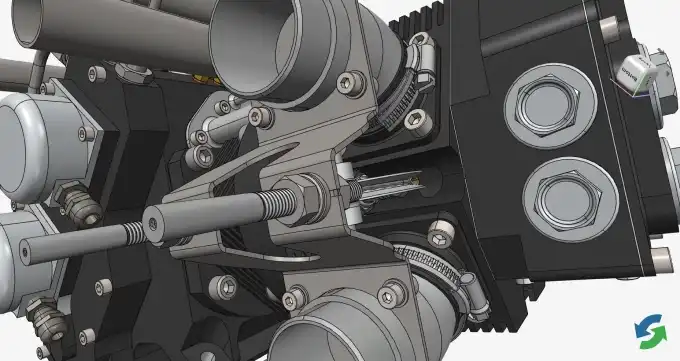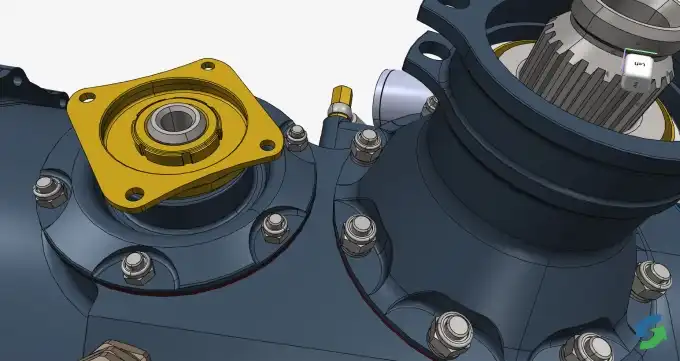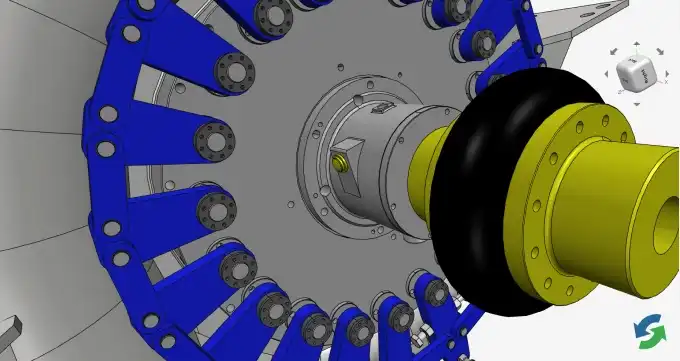Over the years we’ve accumulated a lot of knowledge on what CAD files can be like, what their peculiarities are, and where some of them would and would not be efficient. We’ve already shared a dozen blog posts on this topic, but we’d like to streamline all the information so that you could use it as a CAD files handbook. So since you are already here, go on in and enjoy!
Table of content
- What is a CAD file?
- Which properties can a CAD file store?
- Most common CAD file formats and extensions
What is a CAD file?

CAD (Computer-Aided Design) file is an output of a CAD software, containing information about a designed object. It might consist of 2D or 3D data and is used by designers, engineers, manufacturers, scientists, and digital artists.
The defining characteristic of a CAD file is its format. There are neutral, native and “kernel” CAD file formats.
Neutral file formats, like STEP and IGES, were elaborated as industry standards readable by most of the CAD modelling platforms. The specifications for those formats are publicly available and maintained by companies or consortiums. For instance, IGES is developed by the National Bureau of Standards, while STEP is a product of CAX IF.
Native formats, e.g. SOLIDWORKS, CATIA and DWG, are produced by major CAD vendors. In order to import them in 3rd party CAD tools conversion is required.
Kernel formats are derived from popular geometric modelling kernels, ACIS and Parasolid being the most common ones. A CAD modeling kernel is a component of a modeling software, defining how it mathematically describes a shape. Kernel formats work best with the software that is built on top of the corresponding kernel.
| Neutral CAD formats | Kernel CAD formats | Native CAD formats |
|---|---|---|
| DXFIFCIGESJTSTEP3D PDF3DS3MFColladaFBXOBJPLYPRCSTLU3DUSDVRMLX3DglTF | ACISOpen CASCADEParasolidRhino | CATIADWGPTC CreoSiemens NXSolid EdgeSolidworks3D XML |
Which properties can a CAD file store?

Geometry representation
The two most common ways to represent 3D data in CAD files are meshes and B-Rep, also known as polygonal and boundary representations. B-Rep bodies are defined via a set of precise geometrical entities and topological entities. Mesh model, on the other hand, is a B-Rep’s twin with all precise boundaries replaced with a set of approximated facets. Earlier, we published a blog post, describing the particularities of conversion polygonal formats to B-Rep.
Usage
Geometrical entities are a framework for the future visualization. It stores the information about dimensions and geometric properties of parts: volume, surface area, center of mass.
Format-specific support
CAD file formats differ in their geometry representation scope: IGES supports B-Reps, STL and VRML - polygons, whereas JT may contain both.
Topology
Topology is only a factor for B-Rep representations. Topological shapes include bodies (solid, sheet, wireframe, acorn) and elements (shells, faces, edges, etc).
Usage
While geometry defines a body form, topology defines trimming of underlying geometry and stores connectivity information. Good topology allows predictable modification and animation and has less memory footprint.
Format-specific support
Depending on the CAD format there can be different types of topological entities and different requirements to their representation. The common topological data structure of a CAD model stems from the fact that each Edge is connected to several Faces, which ensures Faces connectivity and is a prerequisite for forming Solids. But there are always exceptions to the rule. For example, in IGES there is no such entity as Edge. Instead, there is an Edge List that doesn’t provide Faces connectivity while converting. Another example of diversity in CAD topology is that while in STEP the outer boundary is mandatory and has its own entity (FACE_OUTER_BOUND), another format may have no such requirement, e.g. Parasolid.
Product structure
Product structure is a hierarchy of single objects called parts and groups of interconnected objects called assemblies.
Usage
On a basic level, thanks to the product structure information there is a collapsible tree view at the left side of the screen in most CAD software packages. We can expand the tree or its groups, tick the checkboxes to hide or show model elements, duplicate the entire assemblies, explore the interrelations of the parts.
Format-specific support
Parts, assemblies and their hierarchy may be described in one of two ways: either in a single file for the entire model (IGES, Parasolid-XT, ACIS-SAT), or in a set of files, one for each part and assembly (SOLIDWORKS, CATIA, PTC Creo, Siemens NX).
Meta-data
Apart from geometry, topography, and structure, CAD files contain meta-data. It includes object names and IDs, user-defined properties, layers, Product and Manufacturing Information (PMI), validation properties.
Usage
Unlike all the previously mentioned properties, meta-data conveys less universal features of the model: specific for its future usage, application industry, further processing steps, etc. It could be the creation date, density of a material, dimension tolerances, or any other arbitrary property.
Format-specific support
The capability to transmit these types of data varies greatly from format to format: STL is the most feature-starved format lacking any of metadata, VRML has a broad support, but can't contain layers and PMI, while STEP and JT supports all the above-mentioned data.
Visual attributes representation
CAD files can also define such visual attributes as colors, materials, textures, line styles, and light sources. These features may be attached both to B-Rep and mesh elements.
Usage
In case displaying the model is at least equally important as processing it, it’s necessary to consider visual attributes. These properties can not just improve the CAD model appearance, but also make its structure and functionality more clear.
Format-specific support
CAD formats differ not only by availability of a particular attribute, but also by the way it’s supported. For instance, colors may be specified via RGB tuples or selected from a predefined list of basic options.
| Read more about CAD data |
|---|
| Geometry representation →B-Rep’s and meshes →Polygonal-to-B-Rep conversion →Model structure representation →Meta-data representation →Visual attributes representation → |
Most common CAD file formats and extensions

CAD data travels between customers, contractors, and investors from department to department. All these stakeholders use different software depending on their role (editor/reviewer), market segment (engineering/manufacturing/sales), or their company size and budget. If CAD files exchange leads to data loss or requires resource-intensive validation for further processing, it might have a negative impact on the whole product lifecycle. That’s why it’s essential to use optimal CAD formats that are more interoperable between existing software packages. Here is a short overview of the most common extensions, as well as their pros and cons.
1. IGES file format
- Extensions: .igs, .iges
- Type: Neutral
- Geometry representation: B-rep, meshes
- Standard: ANSI
- Creation year: 1980s
- Creator: U.S. National Bureau of Standards
IGES (Initial Graphics Exchange Specification) was one of the first attempts to work out an interoperability specification between various CAD platforms. Now it is one of the most wide-spread neutral CAD formats and is supported by Autocad, CATIA, Creo, Siemens NX, and other CAD modelling software.
| Advantages | Disadvantages |
|---|---|
| 1. Vendor-neutral2. Assembly structure, colors, and names support | 1. A B-Rep model as a set of mutually disconnected Trimmed Surfaces2. The generated mesh is generally not water-tight3. Single precision per entire file4. Large file size5. File size limitations6. No PMI |
IGES file format converter and API →
2. STEP file format
- Extensions: .stp, .step
- Type: Neutral
- Geometry representation: B-rep
- Standard: ISO 10303
- Creation year: 1980s
- Creator: ISO
STEP (Standard for the Exchange of Product model data) was the next step in the struggle for CAD interoperability. To define data exchange standards for key industry use cases STEP consists of dozens of APs (Application Protocols), including AP 203 for 3D design of mechanical parts and assemblies, AP 2014 for automotive mechanical design, and an all-encompassing AP 242 for model based 3D engineering in general. These APs and their combinations help to cover all major aspects of design, manufacturing, and product life cycle, which makes STEP the invariably preferred option for exchange between CAx and PDM/EDM systems.
| Advantages | Disadvantages |
|---|---|
| 1. Compatibility with a wide range of CAD, CAM and 3D modelling software packages2. B-Reps, meshes, part-assembly hierarchy, meta-data, visual attributes support3. Excellent PMI support: graphical, semantic, and associations | 1. Above average file size due to long entity names and large entity graphs2. Round-off errors in numerical values due to the text format3. Some data may not be readable in particular workflows (e.g., PMI by CAM software) |
STEP file format converter and API →
Five applications that enabled STEP conversion with CAD Exchanger SDK →
3. ACIS-SAT file format
- Extensions: .sat, .sab
- Type: Kernel
- Geometry representation: B-Rep
- Creation year: 1980s
- Creator: Spatial Corporation, Dassault Systemes
ACIS-SAT is a native format of the ACIS geometric modeling kernel, one of the two most popular ones. This kernel powers numerous CAD, CAM, CAE, and 3D animation platforms, mainly Autodesk apps, paving the way for ACIS-SAT wide application. The format supports two extensions: SAT (Standard ACIS Text) which is human-readable and allows tweaking the model contents manually and SAB (Standard ACIS Binary) which is more compact and safe from the round-off errors.
| Advantages | Disadvantages |
|---|---|
| 1. A fully-fledged B-Rep geometry support2. All B-rep topological entities support: solids, sheet, wireframe, multiple bodies, vertices, non-manifold topology3. Preservation of the design connectivity4. Watertight solid models5. Simple parametric curves and surfaces support6. No translation needed when read by ACIS-based apps | 1. Closed specification2. Lack of part-assembly hierarchy facilities3. Lack of mesh models support4. Less suitable beyond ACIS-based apps5. Limited support of meta-data and visual attributes |
ACIS file format converter and API →
4. Parasolid-XT file format
- Extensions: .x_t, .x_b, .xmt_txt, .xmt_bin, .xmp_txt, .xmp_bin
- Type: Kernel
- Geometry representation: B-rep, meshes
- Creation year: 1980s
- Creator: Shape Data Limited, now Siemens
Parasolid-XT is another persistent format belonging to the modelling kernel. An eponymous kernel is a foundation for such modelling tools, as SolidWorks, Ansys, Solid Edge, Siemens NX, OnShape and others. Just like ACIS, Parasolid format comes in two key extensions: a text-based .x_t, albeit not as readable and editable as ACIS-SAT, and a binary-based .x_b.
| Advantages | Disadvantages |
|---|---|
| 1. No translation needed when read by Parasolid-based software2. Great support of B-Rep geometry3. Complex B-Rep models support with a solid, sheet, wireframe, mixed, and non-manifold topology4. Support of the part-assembly hierarchies5. Support of hybrid models, containing both B-Rep and mesh geometry | 1. Parts and bodies are equated with each other2. Need for conversion of procedural geometry to NURBS3. Limited support of meta-data and visual attributes |
3D formats overview: Parasolid →
Parasolid file format converter and API →
5. JT file format
- Extensions: .jt
- Type: Neutral
- Geometry representation: B-rep, meshes
- Standard: ISO 14306
- Creation year: 1990s
- Creator: Engineering Animation and HP, now Siemens
JT (Jupiter Tessellation after the original name of its ancestral DirectModel toolkit) is a standard collaboration format within Siemens PLM ecosystem. Since it was developed to support visualization of complex assemblies, JT can store a large number of components exported from various CAD systems. Mesh data is the format’s strong suite and it allows loading various LODs according to the visualization scale.
| Advantages | Disadvantages |
|---|---|
| 1. Support of part-assembly hierarchy, mesh and B-Rep geometry, metadata and visual attributes2. Great meshes support: LODs, economical data representation3. Extensive usage of compression4. Binary nature5. On average smaller than STEP with comparable geometry6. Late-loading of data | 1. Its proprietary background causes deviation of support quality throughout the industry |
JT file format converter and API →
6. STL file format
- Extensions: .stl
- Type: Neutral
- Geometry representation: meshes
- Creation year: 1987
- Creator: Albert Consulting Group for 3D Systems
STL (stereolithography) is a file format originally intended for 3D printing purposes, just like the name implies. Nowadays it is used extensively in 3D printing, laser scanning, rapid prototyping, and CAM workflows. But most of the general-purpose CAD packages also support the STL. An STL file defines only the surface geometry and its structure is represented by a flat list of triangles. There are both text and more common binary extensions.
| Advantages | Disadvantages |
|---|---|
| 1. Supported by most of the CAD modeling tools2. Decent quality of general geometric features when converting to other CAD formats | 1. A mesh-only format2. Low performance and a risk of inaccuracy due to lack of connectivity information3. Faceted appearance due to the lack of vertex normals4. No support for part-assembly hierarchy in STL5. No support of flat part lists6. No support of colors at the level of specification7. No specification of the units8. Need for hit-and-miss conversion to B-Rep after 3D scanning |
STL file format converter and API →
7. VRML file format
- Extensions: .wrl, .wrz
- Type: Neutral
- Geometry representation: meshes
- Standard: ISO/IEC 14772-1:1997
- Creation year: 1994
- Creator: Dave Raggett
VRML (Virtual Reality Modeling Language, originally Virtual Reality Markup Language) was the first 3D format tailored to display 3D scenes on the web. It enables website visitors to interact with virtual objects, which is widely used in ecommerce, education, and design projects collaboration. The most common form of VRML is a plain text file, but there is also a gzip-compressed extension. Many 3D modeling programs can save objects and scenes in VRML format.
| Advantages | Disadvantages |
|---|---|
| 1. Capable to store mesh models, materials and textures2. Preserve model hierarchy and attach transformations to its portions3. Intact topology, arbitrary polygons, and other vital attributes support thanks to the indexed meshes4. LODs support5. Advanced features: the viewer's avatar properties, keyframe-based animation, lighting, references to audio, etc. | 1. Number precision limitations and large file sizes due to a text-based nature |
VRML file format converter and API →
8. X3D file format
- Extensions: .x3d
- Type: Neutral
- Geometry representation: meshes
- Standard: ISO/IEC 19775/19776/19777
- Creation year: 2001
- Creator: Web3D Consortium
X3D (Extensible 3D) became a successor of VRML in the field of web-based 3D graphics. It differs from VRML by the support of shaders, geo-location, animation, scene-related data, NURBS encoding of the surface geometry, and other additional features. X3D has an XML-based extension, VRML encodings, and binary one.
| Advantages | Disadvantages |
|---|---|
| 1. Capable to store mesh models, materials and textures2. Preserve model hierarchy and attach transformations to its portions3. Intact topology, arbitrary polygons, and other vital attributes support thanks to the indexed meshes4. LODs support5. An ability to store metadata in the form of key-value pairs6. Shaders, particle effects, volume rendering and rigid body physics7. CAD-specific features: support for NURBS, a mechanism to designate elements as assemblies, parts and faces | 1. Support across 3D apps is rather spotty. can be encountered as one of the import or export options not quite often2. Number precision limitations and large file sizes due to a text-based nature |
X3D file format converter and API →
We look forward to adding more information to this article and cover the bigger scope of CAD file-related topics. If you feel like something is missing here, please let us know at info@cadexchanger.com.